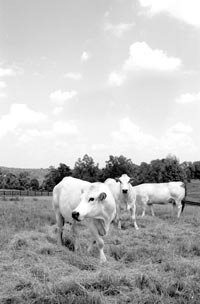No mad butchers: 'Let 'em eat steak'

Word right before Christmas that a cow in Washington state had been infected with mad cow disease didn't stop Central Virginians from tucking into their holiday roasts.
Local butchers and steakhouses report that the demand for beef remains on a holiday high.
And beef purveyors foresee one outcome from the bovine spongiform encephalopathy scare: dropping beef prices, thanks in part to the ban on U.S. beef in Japan and at least 10 other countries.
Mad cow is a fatal disease that basically eats your brain and has no cure. Worldwide, 153 cases have been reported, and most– including the lone case in the United States– are linked to the mad cow epidemic in England in the 1980s.
The U.S. government maintains American beef is safe to eat. Still, those in the county food chain can't help but wonder how fears about the disease will affect local producers and consumers.
"Public perception is the real key here," says Albemarle cattleman Ed Scharer. "It isn't the danger of getting mad cow."
Before the infected Holstein was discovered, "beef prices were historically high," says Scharer, who sits on the boards of the Virginia and the Albemarle County Farm Bureaus.
"A drop in price," he notes, "will be borne by the farmer." He says Albemarle has approximately 600 beef producers, with an average herd size of 30 to 40.
"Once it happened in Canada with no body of water in between us I felt it a matter of time before it would show up here," he says.
Scharer thinks the Washington state case will probably be the only one. "That would show the system is working," he says.
The butchers at Foods of All Nations saw no slowdown in beef sales over the holidays. In fact, in the three days before Christmas, the meat department did $40,000 in sales, with a hefty percentage of that in beef tenderloins and rib roasts, according to meat department manager Robert Collins.
"We have to cater to our clientele," says Collins. "We try to buy the best." That means buying grass-fed beef.
Any worries that mad cow is going to affect beef sales, which traditionally slow in January? "I ate a steak this morning," says Collins. "We just sold a bunch of beef this morning. We're still doing great business here at Foods of All Nations."
Collins does believe that the disease is going to affect other grocery stores. "Steaks are on sale for $2.99 a pound at Reid's and Food Lion," he notes. "We can't even buy it at that price."
"I'm sure it's going to affect us," says a butcher at Anderson Carriage House, who declined to give his name. Anderson's beef comes from Kansas. "Our normal clientele knows our beef is grain-fed and natural," he says.
He thinks grocery chains are more likely to be affected than small businesses like Anderson's. "I'm not backing off beef purchases," he says. However, "I'm looking at everybody feeling the effect in the next week or two."
Any changes in his beef consumption? "I had some for lunch," he replies.
"We haven't seen any change," says Harris Teeter spokeswoman Jennifer Panetta. "The meat guys are saying they're not seeing any effect."
And while some customers reported great deals on steaks at H-T last week, Panetta declines to discuss pricing. "If [beef] was on sale, it was already planned," she says.
On the steakhouse end, the Downtown Grille saw no slowdown in customers wanting to welcome the new year over their favorite cut of beef.
"We've been booked the past two days," general manager Robert Sawrey told The Hook on New Year's Eve.
The Grille's corn-fed steaks come from the Ruprecht Company in Chicago, one of the nation's oldest wholesalers, and which supplies chains like Ruth's Chris.
While Sawrey is confident of his beef, he understands how fears can affect everyone in the food chain, from restaurants and grocery stores to farmers and feed stores.
For at least one local retailer, mad cow has been good for business. "It's just helping us increase our beef sales, and bison has picked up," says Georgetown Farm Market sales manager Corin Major.
She attributes the boost to the all-organic nature of Georgetown Farms' bison and Piedmontese silver beef.
Although there's a national ban on using cattle brains and spinal tissue as feed– considered the primary culprits in spreading mad cow disease– the industry has rejected the notion of a ban on all beef byproducts.
"We do not feed our animals byproducts," says Major. Byproducts are cow leftovers such as bones, cartilage, and tendons.
"And we slaughter at 18 months," adds Major. "Mad cow takes three to five years before it shows up."
Locally, mad cow is seen as a west coast problem. So did an ad touting "U.S.D.A. western steer" sirloin steaks at Great Valu in Crozet last week deter beef eaters?
"Naw," says meat manager V.L. James. "We're still selling plenty of 'em."

These Albemarle cows don't look mad
PHOTO BY JEN FARIELLO
#